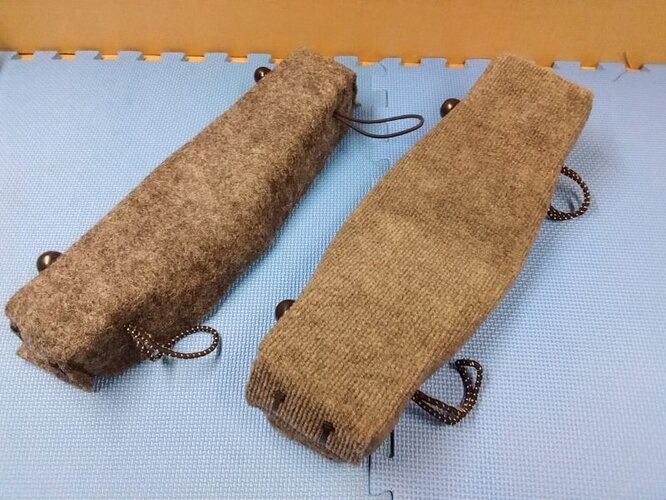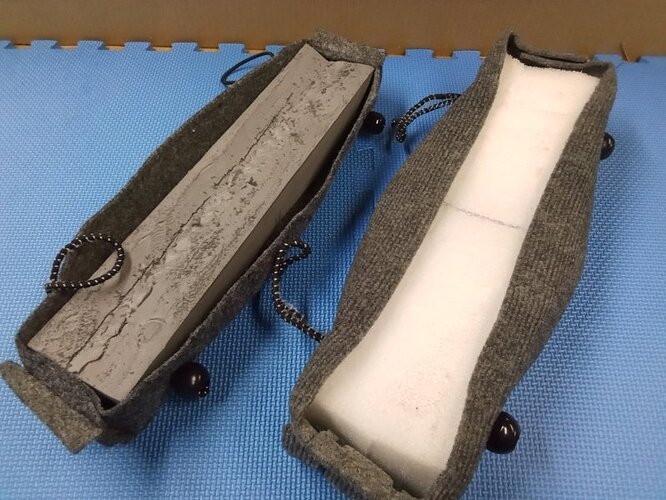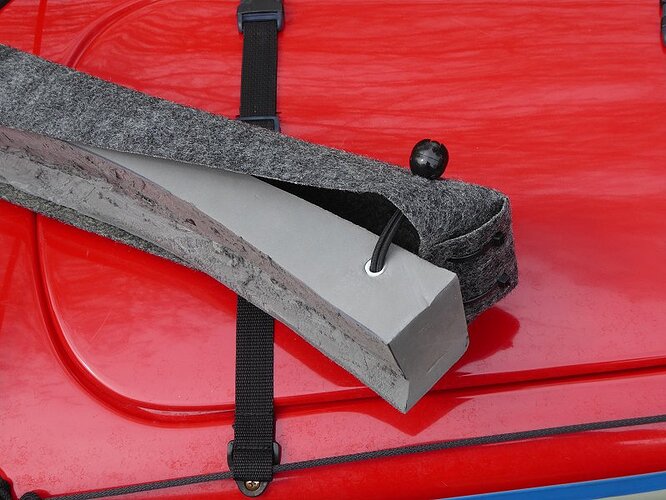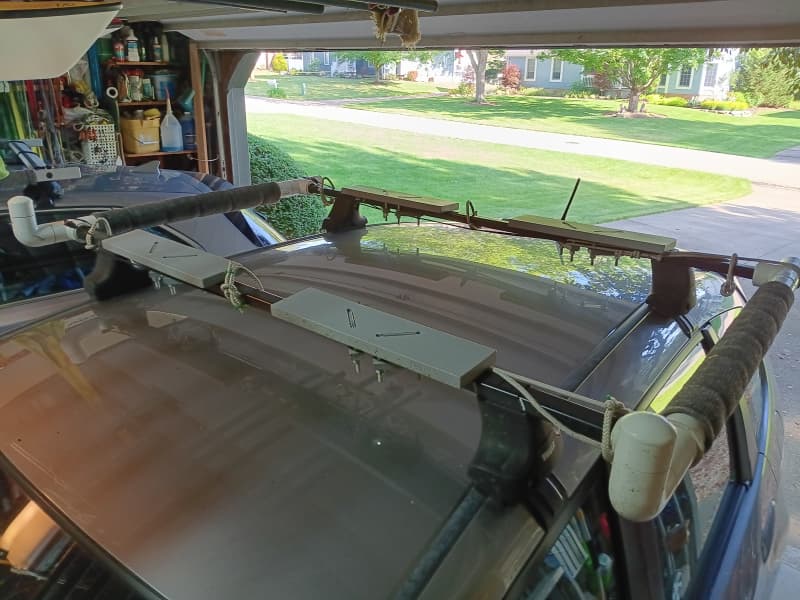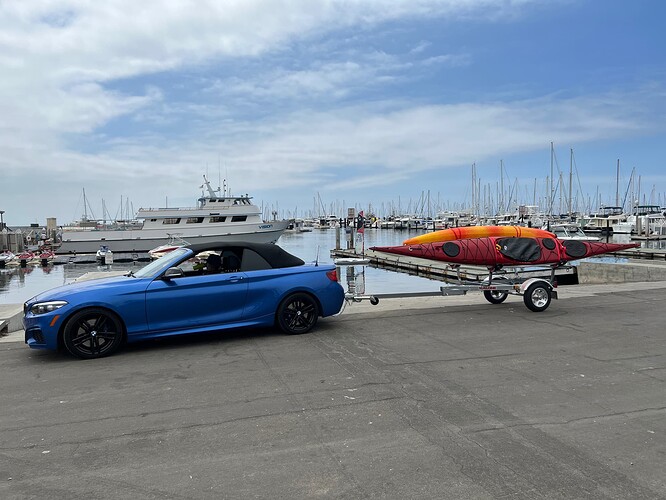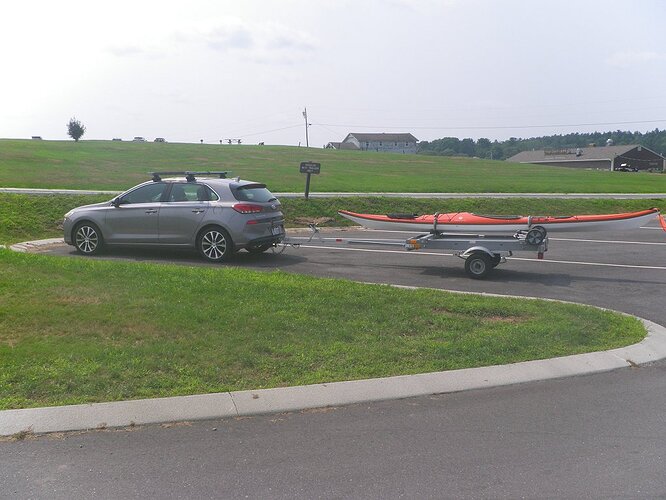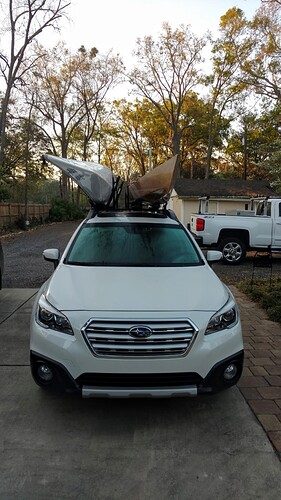Excellent points. Yes, I’m looking at Thule rack and 53 inch crossbar for my CX-5. Also, I agree about the antenna fin. That’s going to be annoying, if not a serious issue. That would be a PIA if I can’t open the hatch with 11-foot kayaks on top. We’ll see. I have to assume that you have more problems with your long boats. I might like a hitch. Does U-Haul really do installations of those? I’m trying to avoid needing J-cradles up top. With regard to parallel parking, I’m assuming the backup camera will be useful. In your picture, your kayaks seem tilted to the rear. Why is that? Are the crossbars not level? Also, I’d like to avoid having to tie down the front and rear of the kayaks. I did that at first with my Tribute, and then just decided to blow it off. Maybe you need to do that becuase of your long kayaks?
You should ALWAYS use bow and stern lines when traveling with boats on your roof. Always. Period. A failed cam strap or rack component could cause not just damage to the boat but also to any vehicle following you and even maiming or fatal injuries when your kayak flies off the car.
Having bow and stern lines also allows the driver to monitor whether boats on the rack may have shifted. Straps can loosen as you drive, especially in rainy weather when the straps get wet. Having the bow lines right in front of you means that you can see if the boats are aligned. To secure the bow lines, I have nylon webbing loops attached to a chuck of heavy rubber tubing that lock under the side edges of the car hood so I can attach nylon lines between the kayak bows and the loops.
Yes, certain large U-Haul dealers sell and install tow hitches – I have had them installed them on several of my cars and trucks Usually costs about $300 to $350 for a Class 2 light duty hitch like I have, a little more for a Class 3 (got one of those for my larger Volvo when we had a camping trailer that was 4200 pounds).
The 18’ skin on frame green kayak on the Mazda is an Greenland replica with a deep bow and low profile stern deck, which is why they dip like they do – my rear Thule rack is only slightly lower than the front one, probably just an inch or two. Most kayaks are somewhat taller in the bow section than the stern, but this is exaggerated in Greenland style boats. The lime green Venture Easky LV behind it is also a Greenland style hull. Hence the swooping shape.
I prefer to carry my kayaks on long highway trips upside down for several reasons. One is that they can’t fill up with water in heavy rains, also they are more aerodynamic that way and less likely to catch wind – the CX-5 is a lightweight car and you do feel crosswinds in when carrying large boats upright. Also, because the cockpit coamings on just about all of my boats fit snugly between the two Thule bars, they locked in place fore and aft and are far less likely to be able to shift in quick stop situations. Also, if you are hauling plastic rotomold boats in hot weather, the hulls soften with the heat and sitting on the rack can cause dents and oilcanning. The decks are more resistant to that and even if they do get slightly deformed, it will not affect the performance. I have seen some really badly deformed rotomold boats that spent too many hours during the summer heat hull-down on a roof rack.
When I load my boats, usually from the rear of the car, I do it hull down but then stand on a short folding step stool and reach up and flip them over once they are on the rack.
OK, I got a 2025 CX-5. The Mazda roof racks were going to be inadequate - only 48" wide. Not appropriate for tiedowns of two two-foot wide Kayaks laying flat next to each other. I got a Yakima Baseline rack, with 60" wide crossbars. Very nice. Now, these new Yakima crossbars are only 30" apart, which is less than the 36" crossbar separation I had on my Tribute. I was worried that the kayaks might rock a bit. But they don’t. Those Yakima racks are, however, a little awkward, because the crossbars are 3" wide. I have foam cushions that accept 2.5" wide bars, which barely work for these crossbars, and I have purchased cushions which accept 4" wide bars, which might be loose. Have not found cushions that are well matched to these Yakima crossbars. Very hard to get inner dimensions on these cushions, in any case. So, all in all, I’m good.
If you mean the gray foam blocks that cradle the kayaks, I made my own modified blocks that would work with different bar widths. I took a “standard” foam block with a flat bottom (meant to go right onto naked car roof), pierced two holes through them to feed some short ball bungees through, and then I wrap the ball bungees around the bars. I also made covers out of cheap indoor/outdoor carpet to make it easier to slide the kayaks onto them, plus that protects them from UV exposure. The holes through the foam are 1/2 inch in diameter and I used 1/2 inch PEX water pipe as liners for the holes (so the ball bungees wouldn’t dig through the foam). I also cut a shallow vee into the bottom of the blocks so they rest more securely on the curved tops of the bars.
You can make these out of any foam block. It doesn’t have to be a pricey gray kayak block. My pictures also show a version made with some white packing foam. The white one has a deeper vee.
The only drawback of these cradles is that you can’t buy them and I think their really pretty slick. So, I remove them whenever I’m parked at a launch so that no one steals them. But that’s quick to do.
(My first photo shows other unrelated roof rack modifications)
(The bottom of the block is bent into a curve because of the partially removed cover)
Nearly any car will work. Pay attention to the roof racks. See if they have rain gutters. I really liked pulling a canoe trailer. Very easy to load, and they slip through the wind better than kayaks on the roof.
Remember to use red flags on each side of vehicle if kayaks or racks extend any distance beyond the vehicle width…or look into it.
That’s an interesting strategy for DIY kayak cushions. But I was hoping for a cushion with a cutout that would accept a rectangular crossbar. That way, when you slide the kayak over it, it won’t roll over. This was a big problem on my Tribute crossbars, which were round. That is, I want a cushion that really hugs the crossbar. The large bore “truck” style cushions I’m buying may be loose, but I can tighten them up by gluing in some padding that makes the 4" acceptance slot only 3" wide.
Nope, my crossbars at 60" long, and the width of a CX-5 is 72". Two kayaks side-by-side eat up only 48" of that 60".
For rectangular cross bars, I attached larger flat pads (held on with U-bolts) to widen the cross bar. That way I can use my cradles on either car, as well as on my trailer which has 2x4s for the cross bars.
Yakima has crossbars, some up to 78". Depending on the roof rails, many saddles can be mounted one inside and one outside the roof rails to give you plenty of width for carrying boats.
Bolting on larger flat pads that fit the truck-style foam pads is an interesting idea, but I don’t much like the idea of driving around with clunky-looking stuff up top.
When I was with the ACA I secured Subaru as an organizational sponsor. It was when they came out with the Outback, and it provided a nice blend of some off-road capability with a lower roofline for easier access with boats. The downside is that they are very much a transportation appliance.
11’ long and 24" wide doesn’t seem correct. You are definitely into the length of a very rec oriented boat, but the width of a touring boat.
The Xterra has been discontinued in the USA for a decade.
I have a Nissan Rogue. Before that I had a Subaru Forester, and before that a small sedan. I test drove the Toyota Rav4, Honda CRV, and many others before deciding on the Rogue. Most small SUVs and crossovers work fine for hauling kayaks. Most small cars can too.
If available, I recommend getting a vehicle with factory rails and installing your own crossbars. That ensures that the rails are level regardless of how curved (or not) the roof of your vehicle is, and installing your own crossbars on them allows you to adjust the spread/distance between them and remove them for better aerodynamics and fuel efficiency when you don’t need them. The best part is having your own universal crossbars also allows you to transfer your investment to your next vehicle vs getting a model specific rail system you have to repurchase every time you get a new car.
My Forester had factory crossbars, which I quickly learned I didn’t like. They always whistled at higher speeds, weren’t adjustable at all, and removing snow from my roof was a pain in the winter. I went with factory rails and universal (but inexpensive) Malone crossbars for my current vehicle and am super happy with the setup. On those I use something similar to the Thule Stacker (whatever model I have is discontinued) to mount one or two boats. If I’m only using one boat I find inexpensive foam blocks a bit easier, but since I switch back and forth between solo paddles and going with my husband, the stacker works well. It can be folded down when not needed. We have wider rec boats (my Wilderness Systems Pamlico 120 is 29" wide, our Old Town Cayuga 130 is 25" wide, both are right around 50 lbs) and that works fine for them. I will say while J-saddles take up less room than lying the boats flat, they still carry boats fairly wide compared to using a stacker that carries a boat on its side.
I’m 5’5" so it is a challenge to load boats solo (but very easy with two people). I have figured it out though, and bring a small foldable step stool with me just to make everything a bit easier. If you are short, consider the roof height of any vehicle you are looking at. If I were any shorter I don’t think I would be able to load my boat without assistance, but it was easy peasy on my little old sedan.
I’m gonna counter a lot of the assumptions here and just suggest that a trailer might be a good option. Almost any car can pull a kayak trailer then you don’t have to worry about what racks do and don’t fit and how you’re gonna lift up the boats that high. One of the convenient things I find about my trailer is that that’s also my boat storage. I just wheel that into the back of the garage and I’m done.
Also means that I could have the convertible that I wanted.
A trailer is not the best solution for many people. You have the cost of the tailer, a tow package, title, insurance, tags, maintenance, etc. Some states require annual inspection. Increased tolls. You have to have a place to store the trailer. Few people have the garage space. It can be a pain to park other than at home or a boat launch. In Maryland, for every county except Queen Anne’s, which requires a permit for all vehicles at their public launches, car top boats park and launch for free. However, each and every other county requires a separate expensive permit for a trailer. If where you live is governed by an HOA, many prohibit trailers parking on the street or even visible on your own property.
Well, there’s something I hadn’t thought about! ![]()
I agree that a trailer may not be the best solution for many people, but I also believe it’s an often overlooked option that could work well for many that aren’t really aware of what’s out there.
To be sure, it was not particularly inexpensive, but on the flip side, it did not cost any more than my prior Thule aerobar setup with two pairs of Hullavators. In fact it actually cost a a fair amount less in the end. Not everyone feels the need to spring for Hullavators, but they were necessary in my wife’s case as an RA sufferer. And of course those Hullivators had no way to mount on my car.
Registration in my state was a nominal one-time cost for a permanent plate - $20 for five years covers the plate renewal, insurance is minimal, no inspection, no tolls in my area. In terms of garage space, if I bother to take the boats off, I can stand the trailer up on end either in the back of the garage or around the side of the house. Very small footprint.
Where I live, there is a parking advantage as now I can park in the relatively ample trailer spots near the launch point instead fighting for the often very limited car parking farther back from the harbor. The other launch points I use down the coast have similar parking advantages for vehicles with trailers.
The whole switch from racks to a trailer has been nothing but a plus for us.
A friend of mine with a Miata convertible had tow hitch receivers mounted on the front and back and used removable T-bars to carry his 18’ kayak.
I like the look of a low, station wagon-like hatchback, and the lower roof makes loading easier. Mine is a 2020 Hyundai Elantra GT. That was the last year they sold these in the USA, essentially replacing it with the Kona SUV. The closest car with a similar shape that you can buy new now is the Subaru Impreza.
I have all the bases covered with the Thule rack on the car, and my customized Trailex trailer too. The trailer is wonderful for launches with appropriate parking. But I use several launches with very poor or no trailer-suitable parking at all so I car top there.
I would have a tough time justifying the cost of a new trailer used only occasionally for kayaking. But I can convert mine into an enclosed cargo trailer with removable sides and lid, and I use it to haul items between my year-round and summer locations. Plus, it hauls yard waste, shrubs, lumber, etc.
Sometimes we carry two on our Subaru, Outback. I put the adjustable factory rack on the aft points. One kayak in the angle rack on the factory racks. And the other 17 ft sea kayak on foam blocks.
This picture shows the wood kayak on Yakima cradles that clip onto the factory bars. They aren’t as easy to use as foam blocks.

